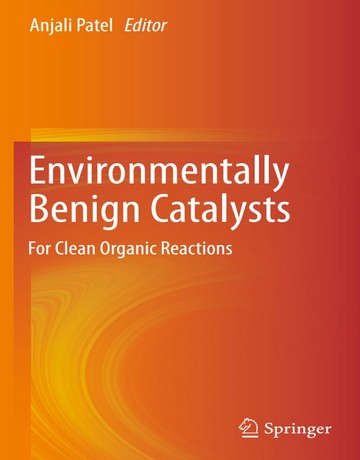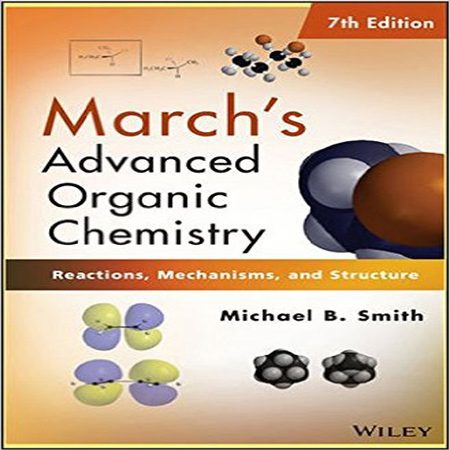واکنش های کلیک در سنتز آلی
دانلود کتاب واکنش های کلیک در سنتز آلی Click Reactions in Organic Synthesis
99,000 تومان
دانلود کتاب واکنش های کلیک در سنتز آلی Click Reactions in Organic Synthesis
کتاب واکنش های کلیک در سنتز شیمی آلی Click Reactions in Organic Synthesis نوشته و تالیف Srinivasan Chandrasekaran از بهترین کتاب های تخصصی شیمی آلی که به بررسی واکنش کلیک در سنتز های شیمی آلی می پردازد.
مشخصات کتاب
- عنوان کتاب: Click Reactions in Organic Synthesis
- فرمت فایل: PDF
- حجم فایل فشرده: 9.81 مگابایت
- ویرایش: 1- August 2016
- زبان نوشتاری: انگلیسی
- نویسنده: Srinivasan Chandrasekaran
- تعداد صفحات کتاب: 349 صفحه
- تعداد فصل ها: 10 فصل
- نحوه دریافت : دانلود فوری و آنی فایل بعد از پرداخت
فهرست مطالب و عناوین فصل های کتاب واکنش های کلیک در سنتز آلی
1 Click Chemistry:Mechanistic and Synthetic Perspectives 1
1.1 Cycloaddition Click Reactions 2
1.1.1 Azide–Alkyne Huisgen 1,3-Dipolar Cycloaddition 2
1.1.2 Copper-Catalyzed Azide–Alkyne Cycloaddition (CuAAC) Click Reaction 2
1.1.2.1 Mechanism of CuAAC Click Reactions 5
1.1.2.2 Catalysts used for CuAAC Click Reactions 6
1.1.2.3 Ligands used for CuAAC Click Reactions 7
1.1.3 Ruthenium-Catalyzed Azide–Alkyne Cycloaddition (RuAAC) Click Reactions 7
1.1.3.1 Mechanism of RuAAC Click Reactions 8
1.1.4 Strain-Promoted Azide–Alkyne Cycloaddition (SPAAC) Reactions 8
1.1.5 Organocatalytic Triazole Formation 10
1.2 Thiol-Based Click Reactions 12
1.2.1 Radical Click Reactions of Thiols 12
1.2.1.1 Thiol–Ene Radical Click Reaction 12
1.2.1.2 Thiol–Yne Radical Click Reaction 14
1.2.2 Nucleophilic Addition Click Reactions ofThiols 15
1.2.2.1 Thiol–Epoxide Click Reactions 17
1.2.2.2 Thiol–Isocyanate Click Reactions 17
1.2.2.3 Thiol–Michael Addition Click Reactions 18
1.2.2.4 Thiol–Halogen Nucleophilic Substitution Reaction 20
1.3 Miscellaneous Click Reactions 21
References 22
2 Applications of Click Chemistry in Drug Discovery and Development 25
2.1 Introduction 25
2.2 Part A: Application of Click Chemistry to Drug Discovery and Development 25
2.2.1 Carbonic Anhydrase Inhibitors 30
2.2.2 Targeting Onchocerca Volvulus Chitinase-1 (OvCHT1) using the Hydroxytriazole Moiety within a Scaffold Hopping Approach 32
2.2.3 1,2,3-Triaole-Derived Anticancer Agents 34
2.2.3.1 Topoisomerase II Inhibitors 34
2.2.3.2 Histone Deacetylase Inhibitors 36
2.2.3.3 Protein Tyrosine Kinase Inhibitors 38
2.2.3.4 Antimicrotubule Agents 39
2.2.3.5 HSP 90 Inhibitors 40
2.2.3.6 Autophagy-Dependent Apoptosis in CancerTherapy 41
2.2.3.7 Anticancer Activity of 4β-Triazole-Podophyllotoxin 42
2.2.3.8 1,2,3-Triazole-Substituted Oleanolic Acid Derivatives as Anticancer Agents 42
2.2.3.9 Anti-Infective Agents 43
2.2.3.10 1,2,3-Triazole Nucleoside 44
2.2.3.11 1,2,3-Triazole Carbonucleosides 45
2.2.3.12 β-Lactamase Inhibitors as Antibacterial Agents 47
2.2.3.13 1,2,3-Triazole-Linked Carbazoles as Antitubercular Agents 48
2.2.3.14 1,4-Diaryl-Substituted 1,2,3-Traizoles as Antimycobacterial (Mtb) Agents 48
2.2.3.15 1,2,3-Triazole-Adamantylacetamide Hybrids as Antitubercular Agents 50
2.2.3.16 Non-Nucleoside HIV Integrase Inhibitors 50
2.2.3.17 MiscellaneousTherapeutic Segments: 1,2,3-Triazole-Linked Dopamine D3 Receptor (D3R) 53
2.2.3.18 Peptidomimetics: 1,2,3-Triazole as a Disulfide Bond Mimetic 53
2.3 Part B: Synthesis of Triazole-Based Drugs Currently in use 54
2.2.1 Tazobactam 54
2.3.1.1 Synthesis of tazobactam from intermediate 102 55
2.3.1.2 Other reports on Tazobactam synthesis 55
2.3.2 Solithromycin 56
2.3.2.1 Synthesis of Solithromycin 57
2.3.3 Cefatrizine 60
2.3.4 Radezolid 61
2.3.5 Molidustat 63
2.3.5.1 Synthesis of Molidustat 63
2.3.6 Tradipitant 63
2.3.7 Carboxyamidotriazole 66
2.3.8 Rufinamide 66
2.3.8.1 Rufinamide–Novartis Process 66
2.3.8.2 An Efficient Synthesis of Rufinamide 68
2.3.8.3 Continuous-Flow Total Synthesis of Rufinamide 68
References 70
3 Green Chemical Synthesis and Click Reactions 77
3.1 Introduction 77
3.2 Huisgen 1,3-Dipolar Cycloaddition 77
3.2.1 Green Perspectives on Reaction Conditions 78
3.2.1.1 Copper(I) Catalysts 78
3.2.1.2 Copper(I) Complexes with Nitrogen- and Phosphorous-Donating Ligands 79
3.2.1.3 Metalated Reagents as Catalysts 82
3.2.1.4 Immobilized Copper Species 82
3.2.1.5 Copper Nanocatalysis 83
3.2.1.6 Other Metals as Catalysts 84
3.2.1.7 Nonconventional Energy Sources 85
3.2.2 Applications to Synthesis 85
3.2.2.1 Regioselectivity of the Alkyne–Azide Cycloaddition 85
3.2.2.2 Different Substitution Patterns on Triazole 86
3.2.2.3 Strain-Promoted Cycloadditions 87
3.2.2.4 Sulfonyl Azides in Huisgen Cycloaddition 87
3.2.2.5 Synthesis of Vinyl-1,2,3-Triazoless 87
3.2.2.6 Triazole Derivative Ligands for Coordination Chemistry 88
3.2.2.7 Tetrazole Synthesis 88
3.2.2.8 Synthesis of Chiral Triazoles 88
3.2.2.9 Synthesis of Triazoles with Luminescent Properties 89
3.2.2.10 Synthesis of Triazole Libraries 89
3.2.2.11 Synthesis of Phosphorylated Triazoles 89
3.3 Other 1,3-Dipolar Cycloadditions 90
3.4 Atom Economy and Simplicity of Procedures in Multicomponent Reactions 90
3.4.1 Reaction Conditions 91
3.4.1.1 Copper Compounds as Catalysts 91
3.4.1.2 Copper Complexes with Nitrogen- and Phosphorous-Donating Ligands 91
3.4.1.3 Immobilized Copper Species 91
3.4.1.4 Copper Nanocatalysis 92
3.5 Summary and Conclusions 92
References 93
4 Synthesis of Substituted 1,2,3-Triazoles through Organocatalysis 99
4.1 Introduction 99
4.2 Preformed-Enolate-Based Synthesis of Substituted 1,2,3-Triazoles 101
4.3 Preformed-Enamine-Based Synthesis of Substituted 1,2,3-Triazoles 106
4.4 Synthesis of Substituted 1,2,3-Triazoles via Catalytic Enolate Intermediates 109
4.5 General Mechanistic Aspects of Enolate Route 113
4.6 Synthesis of Substituted 1,2,3-Triazoles via Enamine Intermediates 114
4.7 General Mechanistic Aspects of Enamine Route 123
4.8 Synthesis of Substituted 1,2,3-Triazoles via Iminium Intermediate 123
4.9 Miscellaneous Routes for the Synthesis of 1,2,3-Triazoles 124
4.10 Conclusions 136
Acknowledgments 136
References 137
5 Applications of the Cu-Catalyzed Azide–Alkyne Cycloaddition (CuAAC) in Peptides 141
5.1 Introduction 141
5.2 CuAAC-Mediated Peptide Conjugation Strategies 142
5.3 CuAAC-Mediated Peptide Backbone Modification Strategies 148
5.4 Conclusions 157
References 157
6 Synthesis of Diverse Carbohydrate-Based Molecules using Click Chemistry 161
6.1 Introduction 161
6.2 Cu-Catalyzed Click Chemistry in the Synthesis of Diverse Glycoconjugates 162
6.3 Synthesis of Carbohydrate-Based Simple to Complex Macrocycles 181
6.4 Click-Inspired Synthesis of Diverse Neoglycoconjugates 185
6.5 Conclusion and Future Perspective 195
Acknowledgment 196
References 196
7 Azide–Alkyne Click Reaction in Polymer Science 203
7.1 Introduction 203
7.2 Linear, Dendritic, and Hyperbranched Polymers 205
7.3 Telechelic and Block Copolymers 220
7.4 Star and Star-Block Polymers 226
7.5 Cyclic Polymers 230
7.6 Side-Chain Clickable Polymers 235
7.7 Cross-linked Polymeric Systems 238
7.8 Porous Organic Polymers 242
7.9 Surface Modification using CuAAC Reaction 244
7.10 Strain-Promoted Click Reaction 247
7.11 Topochemical Azide–Alkyne Cycloaddition (TAAC) Reactions 249
7.12 Summary and Outlook 251
References 251
8 Thiol-Based “Click” Chemistry for Macromolecular Architecture Design 255
8.1 Introduction 255
8.2 Thiol Chemistry for Macromolecular Architecture Design 256
8.2.1 Linear Polymers 256
8.2.2 Graft and Comb Polymers 258
8.2.3 Star Polymers 261
8.2.4 Cyclic Polymers 263
8.2.5 Dendritic and Hyperbranched Polymers 265
8.2.6 Conjugated and Hybrid Polymers 270
8.3 Conclusion 276
Acknowledgments 284
References 284
9 Synthesis of Macrocycles and Click Chemistry 287
9.1 Introduction 287
9.1.1 Peptide- and Sugar-Containing Click Macrocycles 289
9.1.2 Click Macrocycles for Anion Binding and Supramolecular Recognition 297
9.1.3 Clicking Macrocycles to form Mechanical Bonds 300
9.1.4 Cyclic Polymers Obtained by the CuAAC Click Reaction 302
9.2 Summary and Conclusions 304
References 304
10 Modifications of Nucleosides, Nucleotides, and Nucleic Acids using Huisgen’s [3+2] Azide–Alkyne Cycloaddition: Opening Pandora’s Box
10.1 Introduction 309
10.1.1 Nucleoside Modifications 309
10.1.1.1 Nucleoside Analogs as Potential Drugs 309
10.1.1.2 Nucleoside Bioconjugates 311
10.2 Nucleotide and Nucleic Acid Modifications 316
10.2.1 “Artificial” DNA 316
10.2.2 Presynthetic Modification DNA 316
10.2.3 Postsynthetic Modification 318
10.3 Conclusion 331












دیدگاهها
هیچ دیدگاهی برای این محصول نوشته نشده است.